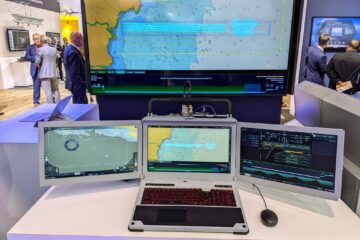Thales press release
Thales launches the world’s first fixed-panel IFF system for the French Navy’s future frigates
Thales is unveiling the TSA6000, the first IFF interrogator to use flat fixed-array active antenna technology. This new solution, unique in the world, provides 360° coverage around the vessel, with no trade-off in range capabilities, and an unprecedented and extremely fast identification capability.
- Identifying air targets after they have been detected is crucially important in the theatre of operations. To meet this need of the Forces, Thales is unveiling the TSA6000, the latest addition to its family of IFF (identification friend or foe) interrogators.
- The fully digital TSA6000 comprises four fixed antenna panels to provide 360° coverage and unprecedented identification performance.
- Smaller, lighter and more efficient than a rotating antenna system, the interrogator can identify targets extremely quickly and is set to revolutionise IFF identification.
Naval forces today need to be able to rely on new technology to make the best decisions when it matters most. Thales helps them conduct their missions more safely at every critical moment, building on its air surveillance expertise and in-depth knowledge of operational contexts to develop high-value end-to-end IFF solutions.
A revolutionary fixed-panel technology
Based on a revolutionary all-digital flat fixed-array technology, the TSA6000 IFF identification system provides a smart 360° electronic scanning (or e-scan) capability enabling extremely fast identification of new types of threats.The four-panel antenna design allows full 360° coverage, overcoming the problem of signal masking caused by a ship’s topside infrastructure, especially if it has multiple masts. Smaller and lighter, the TSA6000 is much easier for systems integrators to position and install on a vessel compared to IFF systems with rotating array antennas or fixed cylindrical arrays.

The TSA6000’s panels are independent from the radar system for even greater flexibility of installation and maintenance. Its modular, scalable all-digital architecture also simplifies support operations significantly: each panel comprises multiple modules for built-in redundancy and to help ensure the system is permanently available. In addition, the system has no mechanical or rotating parts, considerably increasing reliability and reducing time to repair.
The TSA6000 is compliant with Mode 5, the new NATO secure identification standard. With this new product, Thales offers an ultra high-performance identification capability with guaranteed interoperability between NATO and allied forces for the decades ahead.
A comprehensive communication and electronic warfare suite for the FDI frigates
The TSA6000 will equip the French Navy’s future FDI-class frigates from 2021 alongside the Sea Fire radar from Thales, which also has a flat-panel array. The radar / IFF combination will offer a near- instantaneous detection and identification capability against high-velocity threats.
As a global market leader in IFF identification, Thales provides a complete range of IFF solutions to meet the current and future needs of the armed forces. To date, over 20,000 IFF devices from Thales have been installed on 100 different types of land, air and naval platforms in 70 countries.
The TSA6000 is the latest addition to the Thales family of IFF products and meets the full range of current and future operational requirements. With its unique digital architecture, it is designed to evolve in line with emerging requirements and future threats. We’re proud to be providing state- of-the-art and ever more innovative solutions to ensure the highest levels of protection for the armed forces and help them conduct their operations safely.
Florence Gourgeon, Vice President Radio communications, Thales
-End-
Naval News comments
Alongside the Sea Fire radar and the new TSA 6000 IFF, Thales is supplying Aquilon, a secure, integrated and digital naval communications system that guarantees connectivity and interoperability for the frigate and its crew. One of the main components of this system is PARTNER-C, the latest iteration of the PARTNER range of communication management systems which was unveiled last year. According to Thales, PARTNER-C has a new intuitive man-machine interface adapted to sailors accustomed to consumer communications technologies. COMTICS, which Thales described as “the sailor’s smartphone”, will also be available on the frigate. The dual-band SURFSAT-L stations and the HF XL, a new generation of HF radios, will give the FDI enhanced long-distance connectivity in all circumstances.

All these previous systems were already displayed by Thales on previous editions of Euronaval and other international exhibitions. Their integration aboard the FDI was well know since the beginning of the program. But it is the first time that Thales unveiled details about the IFF system that will be coupled with the fixed panel AESA radar Sea Fire. Until now, it was only known that the FDI’s IFF will be a solution from Thales’ BlueGate family.
Finally, it seems that the FDI frigates will be equipped with an entirely new IFF system. Fixed-panel radar and IFF will provide a better 360° real-time air-defense coverage. This increase in performance will be needed in the next decades. Indeed, the FDI frigates are designed to deal with new generation threats, such as hypersonic missiles, stealth aircrafts and swarms of UAVs.
Based on an all-digital technology, the interrogator provides intelligent 360° electronic scanning, enabling identification in a very short time in the face of new threats. Smaller and lighter, the TSA 6000 offers operators ease of layout and installation on the vessel. More efficient, the interrogator is able to detect a threat in a very short time and revolutionizes friend-foe identification. Combined with the SEA FIRE, the radar/IFF pair will thus offer an almost instantaneous hyper- velocity threat detection and identification capability.
Extract of Thales Press kit






